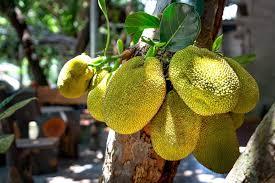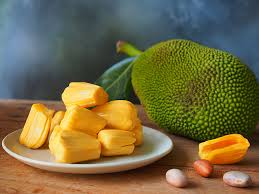Jackfruits, scientifically known as Artocarpus heterophyllus, are fascinating tropical fruits with a multitude of characteristics that make them unique and valuable. These large, greenish fruits are renowned for their sweet taste, distinctive aroma, and versatile uses.
In terms of appearance, jackfruits are sizeable, with a spiky, green exterior that hides a treasure trove of golden-yellow, fibrous flesh inside. The sheer size of a jackfruit can be impressive, as they can grow to be one of the largest fruits in the world. The fruit’s scientific name, Artocarpus heterophyllus, reflects its diverse leaf shapes, adding to its botanical intrigue.
One of the notable features of jackfruits is their sweet flavor profile. The pulp is naturally sweet, reminiscent of a blend of banana, pineapple, and mango. This inherent sweetness makes jackfruit a popular choice for various culinary delights, from desserts to savory dishes.
Beyond its taste, jackfruit boasts an impressive nutritional profile. Rich in dietary fiber, vitamins, and minerals, it contributes to a healthy and balanced diet. Additionally, it is a good source of energy due to its carbohydrate content, making it a satisfying and nutritious snack.
What sets jackfruit apart is its versatility in the kitchen. The fruit can be enjoyed in multiple forms – ripe or unripe. Ripe jackfruit is commonly consumed fresh, enjoyed as a stand-alone fruit or incorporated into salads and desserts. On the other hand, unripe jackfruit has a neutral taste and a meaty texture, making it a popular meat substitute in vegetarian and vegan dishes.
Jackfruit has also gained attention for its environmental benefits. As a low-maintenance crop that thrives in tropical climates, it requires less water and pesticides compared to some other fruit crops. This resilience makes it a sustainable option in agriculture.
In addition to its culinary and environmental attributes, jackfruit holds cultural significance in various regions where it is grown. It is often part of traditional cuisines and celebrations, symbolizing abundance and prosperity.
Jackfruits, scientifically known as Artocarpus heterophyllus, are not merely fruits; they are a testament to nature’s diversity and generosity. Their unique blend of taste, nutrition, and versatility makes them a prized ingredient in kitchens worldwide, while their ecological benefits contribute to sustainable agriculture. Whether enjoyed fresh, cooked, or as part of cultural festivities, jackfruits continue to captivate people with their golden allure and delicious offerings.
Read Also: Rabbit Feeds and Feeding Guide
The History of Jackfruits

The history of jackfruits is deeply rooted in the tropical regions of South and Southeast Asia. Believed to be native to the rainforests of the Western Ghats in India, jackfruit has a long and rich history dating back thousands of years.
Archaeological evidence suggests that jackfruit cultivation began in the southwestern rainforests of India, where it flourished in the warm and humid climate. Over time, its cultivation spread to other parts of India, including the Western Coastal region and the Deccan Plateau.
As trade routes expanded, jackfruit found its way to other parts of Asia, including Sri Lanka, Malaysia, Indonesia, and the Philippines. The fruit adapted well to different climates and soil conditions, contributing to its widespread cultivation across the tropical belt.
Jackfruit’s journey beyond Asia can be traced back to the 15th century when Portuguese traders introduced it to Africa. From there, it made its way to other parts of the world through colonization and trade routes. In the 18th century, jackfruit reached the Americas, including Brazil and Florida, where it adapted to new environments and became established.
Throughout history, jackfruit has not only been a dietary staple but also played a role in traditional medicine. Various parts of the jackfruit tree, including the roots, bark, and leaves, have been used in folk remedies for ailments ranging from skin diseases to digestive issues.
In terms of cultural significance, jackfruit has become an integral part of religious and social practices in many Asian countries. In India, for example, it is associated with fertility and prosperity and is often used in religious ceremonies.
In recent years, the global interest in plant-based diets and sustainable agriculture has brought jackfruit into the spotlight as a versatile and eco-friendly food source. Its adaptability, resilience, and minimal environmental impact contribute to its appeal in the face of changing dietary trends and increasing awareness of sustainable practices.
In addition, the history of jackfruits is a tale of cultivation, trade, and cultural integration. From its origins in the lush rainforests of India to its spread across continents, jackfruit has evolved into a globally appreciated fruit with a diverse range of uses and cultural significance.
Nutritional Values of Jackfruits
Jackfruit, a tropical fruit with a distinctive taste and texture, offers a range of nutritional benefits. Here’s a glimpse into its nutritional values:
1. Calories: Jackfruit is a relatively low-calorie fruit, making it a healthy snack option. A typical serving contains about 95 calories.
2. Carbohydrates: It is a rich source of carbohydrates, providing quick and sustained energy. The majority of its calories come from carbohydrates, contributing to around 24 grams per cup.
3. Dietary Fiber: Jackfruit is high in dietary fiber, promoting digestive health and contributing to a feeling of fullness. A cup of jackfruit can provide approximately 3 grams of fiber.
4. Protein: While not a significant source of protein, jackfruit contains a small amount, offering about 3 grams per cup. It can be a valuable addition, especially for those following plant-based diets.
5. Vitamins: Jackfruit is rich in various vitamins, including vitamin C, an antioxidant that supports the immune system. It also contains small amounts of B-complex vitamins like thiamine, riboflavin, and folate.
6. Minerals: Potassium, magnesium, and manganese are among the minerals found in jackfruit. Potassium is essential for maintaining proper heart and muscle function.
7. Antioxidants: The fruit contains antioxidants that help combat oxidative stress in the body. These antioxidants contribute to overall health and may play a role in disease prevention.
8. Phytonutrients: Jackfruit contains phytonutrients, which are plant compounds with potential health benefits. These compounds may have anti-inflammatory and anti-cancer properties.
It’s worth noting that the nutritional content can vary slightly depending on whether the jackfruit is consumed ripe or unripe. Ripe jackfruit tends to be higher in sugars, while unripe jackfruit, often used as a meat substitute, has a more neutral taste and lower sugar content.
Incorporating jackfruit into a balanced diet can offer a delicious way to consume essential nutrients and contribute to overall well-being. Whether enjoyed fresh, cooked, or as part of various dishes, jackfruit provides a unique combination of flavor and nutrition.
Read Also: Principles of Housing and Sanitation for Rabbits
The Health Benefits of Jackfruits

Jackfruit, beyond its delicious taste and versatility in the kitchen, offers several health benefits due to its nutritional composition and natural compounds. Here are some potential health advantages associated with the consumption of jackfruit:
1. Rich in Nutrients: Jackfruit is packed with essential vitamins and minerals, including vitamin C, potassium, dietary fiber, and various B vitamins. These nutrients play crucial roles in immune function, heart health, and overall well-being.
2. Dietary Fiber for Digestive Health: The high fiber content in jackfruit supports digestive health by promoting regular bowel movements and preventing constipation. Fiber also helps maintain a healthy gut microbiome.
3. Low in Calories: For those looking to manage their calorie intake, jackfruit is a favorable option. It provides a satisfying and flavorful addition to meals without adding excessive calories.
4. May Aid in Weight Management: The combination of fiber, low calorie content, and a moderate amount of carbohydrates in jackfruit can contribute to feelings of fullness, potentially aiding in weight management when part of a balanced diet.
5. Potential Blood Pressure Regulation: Jackfruit is a good source of potassium, a mineral that plays a role in regulating blood pressure. Adequate potassium intake can help balance sodium levels and support cardiovascular health.
6. Antioxidant Properties: The fruit contains antioxidants such as vitamin C and phytonutrients, which help neutralize free radicals in the body. This may contribute to reducing oxidative stress and lowering the risk of chronic diseases.
7. May Have Anti-Inflammatory Effects: Some compounds found in jackfruit, including flavonoids and other phytonutrients, have anti-inflammatory properties. Chronic inflammation is linked to various health conditions, and consuming anti-inflammatory foods may help mitigate this risk.
8. Supports Immune Function: The vitamin C content in jackfruit supports the immune system by promoting the production of white blood cells and assisting in the body’s defense against infections.
9. May Have Anti-Cancer Properties: Certain compounds in jackfruit, including antioxidants and phytonutrients, have been studied for their potential anti-cancer effects. While more research is needed, the preliminary findings suggest a promising avenue for further investigation.
It’s important to note that individual responses to food can vary, and moderation is key in maintaining a balanced and healthy diet. Including jackfruit as part of a diverse and nutritious eating plan can be a tasty way to reap its potential health benefits. As with any dietary changes, consulting with a healthcare professional or nutritionist is advisable, especially for those with specific health concerns or conditions.
How to Grow Jackfruits (Growing Guide)
Growing jackfruit requires attention to its tropical nature and specific environmental needs. Here’s a general guide to help you cultivate jackfruit successfully:
1. Climate: Jackfruit thrives in tropical and subtropical climates. It requires consistently warm temperatures and cannot withstand frost. Ideally, the temperature should stay between 77°F to 88°F (25°C to 31°C).
2. Soil: Choose well-draining soil with a slightly acidic to neutral pH (6.0 to 7.5). Sandy loam or loamy soil is preferred. Good drainage is essential to prevent waterlogging, which can be detrimental to jackfruit trees.
3. Planting:
Seed Germination: Jackfruit seeds can be used for propagation. Soak seeds in water for 24 hours before planting to enhance germination.
Germination Medium: Plant seeds in a seed-starting mix or a well-draining potting mix.
Pot or Ground: Start jackfruit seeds in pots or directly in the ground. When transplanting, ensure a spacing of at least 20 feet between trees.
4. Sunlight: Jackfruit trees require full sunlight for optimal growth. Choose a location where the tree will receive at least 6 to 8 hours of direct sunlight daily.
5. Watering:
Young Trees: Water regularly, keeping the soil consistently moist but not waterlogged.
Mature Trees: Once established, jackfruit trees are somewhat drought-tolerant. Water deeply but infrequently.
6. Fertilization:
Young Trees: Use a balanced fertilizer with a higher nitrogen content for the first few years.
Mature Trees: Switch to a fertilizer with higher potassium content to support fruit development.
7. Pruning: Prune the tree to maintain its shape and remove any dead or diseased branches. Pruning can also help manage the tree’s size.
8. Mulching: Apply a layer of mulch around the base of the tree to retain soil moisture, suppress weeds, and regulate soil temperature.
9. Pests and Diseases: Monitor for pests such as aphids, mealybugs, or fruit flies. Treat with insecticidal soap or neem oil if necessary. Watch for signs of fungal diseases, and ensure good air circulation around the tree.
10. Harvesting: Jackfruit trees typically start bearing fruit 3 to 4 years after planting. Fruits are ready for harvest when they change color and emit a sweet aroma. Cut the fruit carefully to avoid the latex, which can be sticky.
Growing jackfruit requires patience, attention to environmental conditions, and proper care. By providing the right climate, soil, and care, you can enjoy the satisfaction of cultivating this tropical treasure in your own space.
Read Also: The Concept of City Fitness, It’s Characteristics and Economic Impacts
